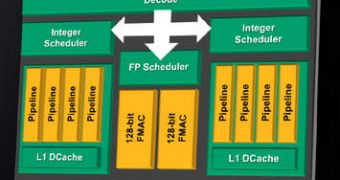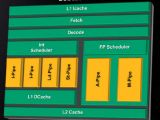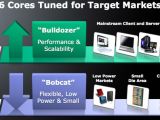After having been in development for years, the Bobcat and Bulldozer architectures from Advanced Micro Devices are finally getting ready to materialize into actual products, and the company is taking advantage of the annual Hot Chips conference to disclose some details, while still keeping quiet about the performance of planned processors.
The Bulldozer architecture will be the basis for new products in the markets for such things as mainstream laptops to high-end servers.
The Bobcat architecture has already spawned the Ontario processors, samples of which already exist in the IT player's labs, and this part will power new netbooks and ultrathin/ultralight laptops.
"Both cores are highly innovative, but the proof of the pudding is in the tasting and no one has had a chance to taste these guys," said Nathan Brookwood, principal of market watcher Insight64.
Bulldozer will have two integer execution pipelines and will have frequencies higher than 2.3 GHz, and its second integer pipeline makes do with only 12.5% more die area. Basically, the Bulldozer module will be seen as two cores instead of one.
The performance for this dual-core approach varies depending on workload, but boosts will apparently go as high as 80% instead of the 20% or less that Intel's Hyperthreading allows.
Each Bulldozer integer block has 16 Kbyte of L1 data cache and they share a 64 Kbyte instruction cache.
What's more, though L3 cache will sometimes be absent entirely, the chips will be able to choose from a variety of secondary and tertiary caches.
Bulldozer also has a floating point unit with 128-bit multiply-accumulate units. Basically, these chips are the first to include such dedicated hardware, but the complexity of the architecture poses some execution risks.
"We have invested in methods for workarounds using microcode and other features to turn non-essential optimizations off, so we feel pretty good about getting to market in the windows we are talking about," said Chuck Moore, an AMD corporate fellow and chief technology officer of technology development.
Bobcat is expected to have half the die size and power draw of existing mainstream notebooks, even while boasting 90% of their performance.
Essentially, it is a synthesizable x86 core that uses out-of-order execution, making it 20 to 25% stronger than in-order chips.
The first Bobcat chip, the Ontario, will even have a DirectX 11-capable Radeon graphics core and is based on TSMC's 40nm process.
"At a couple Watts, a Bobcat chip should outperform an Atom because Bobcat has these architectural goodies that Atom threw out to get to rock-bottom power consumption," said Nathan Brookwood, principal of market watcher Insight64 (Saratoga, Calif.).
"And with a Radeon DX11 core, the AMD chips will have much better graphics than Intel," he added.
Bobcat chips might be completed by the end of the year, but will only be truly available in early 2011. Bulldozer chips, based on Globalfoundries' 32nm process, will come in 2011 as well.

 14 DAY TRIAL //
14 DAY TRIAL // 

